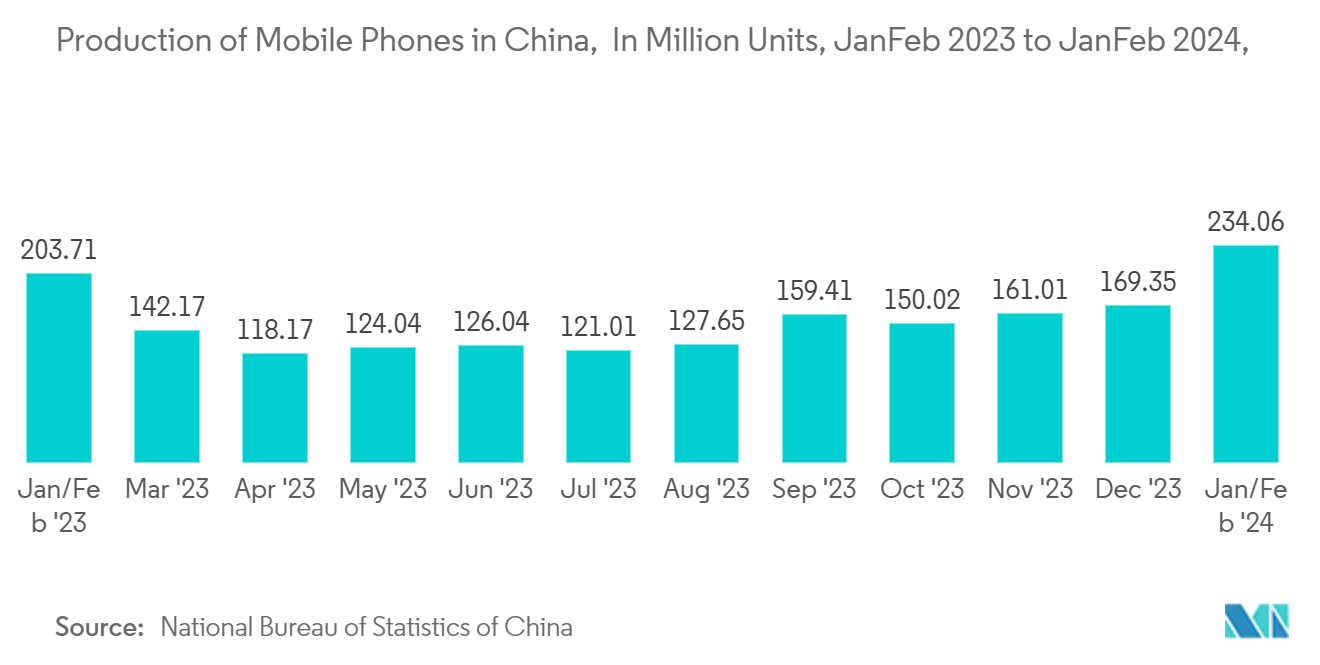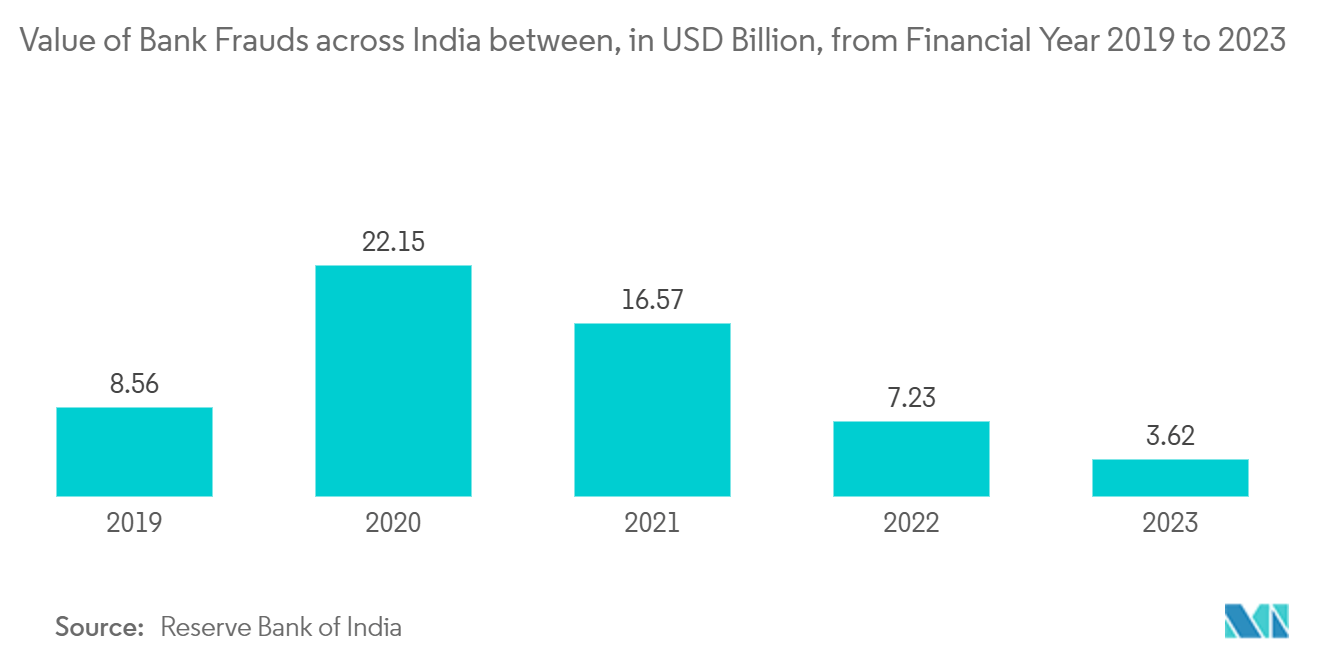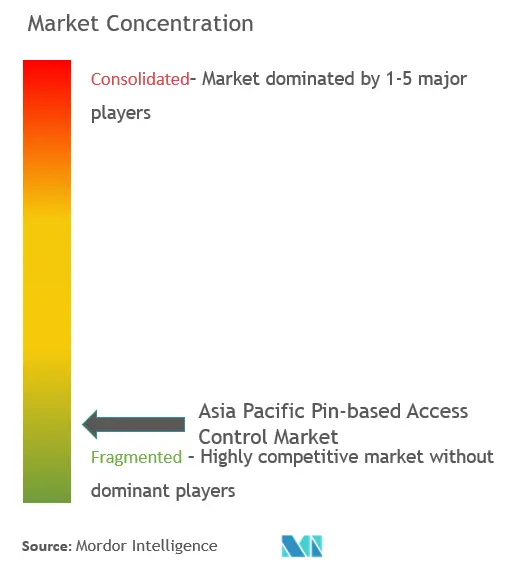Asia-Pacific Pin-based Access Control Market Size and Share

Asia-Pacific Pin-based Access Control Market Analysis by Mordor Intelligence
The Asia-Pacific Pin-based Access Control Market size is estimated at USD 706.99 million in 2025, and is expected to reach USD 941.66 million by 2030, at a CAGR of 5.9% during the forecast period (2025-2030).
- Rising privacy and security concerns and increased data theft are driving the market's growth. Global incidents of terrorism and escalating crime rates have highlighted the need for enhanced safety measures, as infrastructure damage and loss of lives remain significant risks. Access control systems have become essential in regulating entry to commercial, business, and residential premises, enhancing property security for occupants and staff.
- In today's dynamic environment, SMEs must prioritize security planning to address evolving threats. Pin-based access control systems are gaining popularity due to their compatibility with existing infrastructures, making them an ideal fit for older security setups. These systems offer scalability, flexibility, and robust security features.
- Supportive policies and the rise of IoT are driving the adoption of smart homes in Asia-Pacific. GSMA projects that by 2025, the region could host approximately 4.1 billion IoT connections, representing nearly a third of the global population. The Chinese access control market is also poised for significant growth, driven by initiatives such as the Smart Cities Projects, the National New-type Urbanization Plan, and the Made in China 2025 strategy.
- End-user industries, including healthcare, industrial, government, and hospitality, that house numerous critical and valuable assets. Any security breach or lapse could prove disastrous, leading to significant revenue losses. Consequently, these regional industries increasingly adopt stringent measures, leveraging cutting-edge technology such as pin-based access control systems to safeguard sensitive customer data.
- Pin-based access control systems face heightened vulnerability to hacking, potentially stunting the market growth in the region. As transactional technologies see rapid adoption, the need for robust identity verification is surging. Consequently, biometric access controls are gaining consumer favor, overshadowing traditional pin-based systems and impeding market expansion.
- Rising inflation rates have increased the cost of goods and services, including pin-based access control systems. Higher costs lead to reduced purchasing power for consumers and businesses, slowing the market's growth. Further, the ongoing war between Russia and Ukraine has disrupted the global supply chain, particularly affecting the availability and cost of electronic components and raw materials used in pin-based access control systems. This is leading to delays in production and increased costs for manufacturers.
Asia-Pacific Pin-based Access Control Market Trends and Insights
The Large Enterprises Segment is Expected to Hold a Significant Market Share
- Access control systems are the most convenient method of managing access to business premises, offices, and businesses. An access control system may be developed to limit physical access in IT rooms where confidential data is gathered. Due to increasing security consciousness, the increasing demand for high-level access control systems, and the adoption by commercial enterprises of access control equipment, the access control systems market is expected to grow.
- As commercial door lock systems with keypads provide enhanced security, eliminating the need for physical access keys, several property owners and senior management professionals alternate the PIN code from time to time to ensure that only authorized personnel can access the space.
- Furthermore, the traditional method of keeping track of time and attendance has resulted in expensive mistakes and aggravating inefficiencies because employees had to fill out paper timesheets to track their working hours. Businesses are upgrading to sophisticated pin-based attendance systems to minimize these efforts. The pin-based attendance systems provide a higher security level and can prevent theft and enhance data security. Companies can also keep track of employees and limit lower-level employee access to specific information, protecting organizational privacy.
- The increasing number of smartphone sales in China is expected to increase the demand for pin-based access control with the integration of mobile applications. Based on data from the National Bureau of Statistics of China, it was observed that China produced nearly 1.60 billion cell phones until November 2023. China has emerged as one of the prominent nations in cell phone manufacturing globally and is expected to maintain steady growth in the foreseeable future. Additionally, it is notable that the Chinese domestic mobile phone market has become one of the largest globally. Furthermore, with technological advancements, organizations are implementing smart door locks to prevent theft and increase the security of sensitive data.

India is Expected to Witness Significant Growth
- The growing industrialization leads to a high demand for securing assets and data. Urbanization in the region is driving the need for access controls in residential and commercial areas owing to security concerns. Technological advancements and digitalization drive the demand for solutions across organizations. Furthermore, the cumulative adoption of smartphones and mobile computing devices is expected to drive the adoption of pin-based access control systems across Asia-Pacific.
- India is witnessing an increase in pin-based access control systems in various sectors, including hotels, government institutions, corporate offices, residential buildings, and retail stores, primarily due to the rapidly growing security concerns and increasing crime rates. Several key players are developing devices per the Indian smart home requirements under the Government of India programs, such as Digital India and Make in India.
- The digital payments ecosystem in India has also grown significantly in recent years, driven by a combination of government initiatives, an increase in internet and smartphone usage, and the rise of e-commerce. One of the key initiatives is the UPI and the BHIM app launch, which allows for real-time inter-bank transactions, simplifies digital transactions and has increased the usage of pin-based access for authorization of transactions. Furthermore, banks in the country use pin-based access control to secure the locker vaults.
- The number of identity theft and bank frauds in India has increased in the last five years. The RBI report reveals a significant decrease in the total number of frauds for FY 2023-2024, dropping to INR 13,930 crore (USD 1.66 billion) from the previous year's INR 26,127 crore (USD 3.12 billion). The proliferation of access control systems helps to reduce bank fraud and theft activities, which is expected to drive the market's growth in India.
- As the popularity of physical and cyber security systems continues to increase, several industries are implementing multi-factor authentication policies to reduce severe security breaches. Two-factor authentication (2FA) is a favored security measure widely adopted by consumers and banks. The Reserve Bank of India (RBI) has issued a directive urging financial institutions to phase out or reevaluate SMS-based One-Time Password (OTP) authentication methods. In India, SMS 2FA is the go-to authentication method for banks, safeguarding access for authorized users.

Competitive Landscape
The Asia Pacific pin-based access control market is fragmented and has several players. Companies in the market continuously try to increase their market presence by introducing new products, expanding their operations, or entering into strategic mergers and acquisitions, partnerships, and collaborations. Some of the major players are Johnson Controls, HID Global Corporation, Hangzhou Hikvision Digital Technology Co. Ltd, and Thales Group.
- February 2024: Hikvision, a leader in innovation, introduced its latest professional access control lineup. This second-generation release marks a notable advancement in access management. The upgraded features span enhanced web management and versatile authentication to specialized access applications and integrated security solutions. Consumers today have various authentication options at their disposal, and these range from conventional card and PIN methods to cutting-edge technologies like mobile identity verification through Bluetooth, NFC, and QR codes.
- May 2024: Opera, a leading global browser innovator, unveiled a major privacy upgrade for Opera Mini. The company introduced 'Locked Mode,' a feature that allows users to browse with a PIN for added privacy. This enhancement directly responds to the demands of 94% of mobile users, especially those who share devices with family or friends, seeking heightened password protection.
Asia-Pacific Pin-based Access Control Industry Leaders
-
Johnson Controls
-
Bosch Security and Safety Systems
-
HID Global Corporation
-
Hangzhou Hikvision Digital Technology Co., Ltd.
-
Honeywell International Inc.
- *Disclaimer: Major Players sorted in no particular order

Recent Industry Developments
- March 2024: Identiv, a leading digital identity provider specializing in IoT security, unveiled its latest innovation: ScrambleFactor. This cutting-edge three-factor authentication reader leverages fingerprint biometrics to enhance physical access control. The device, featuring an LCD touchscreen keypad, supports traditional methods like PINs, RFID, and common access cards and offers advanced fingerprint biometric verification.
- October 2023: Google unveiled a new feature, allowing users to log into their accounts using passkeys. Following positive feedback, Google has decided to roll out passkeys as the default login option for personal accounts. These passkeys can be set up using a fingerprint, face scan, or PIN. Google asserts that this new passkey system is 40% faster and employs advanced cryptography, enhancing security compared to traditional password methods.
Asia-Pacific Pin-based Access Control Market Report Scope
Access control systems are an essential element of security that governs access to specific information, applications, and data sources. They safeguard sensitive information, such as customer and intellectual property information, from being stolen by malicious actors or unauthorized users. Pin-based access control is a popular method of authenticating consumer identity more efficiently.
The study tracks the revenue accrued through the sale of pin-based access control by various players in Asia-Pacific. The study also tracks the key market parameters, underlying growth influencers, and major vendors operating in the industry, which supports the market estimations and growth rates during the forecast period. The study further analyses the overall impact of the aftereffects of the COVID-19 pandemic and other macroeconomic factors on the market. The report’s scope encompasses market sizing and forecasts for the various market segments.
The Asia-Pacific pin-based access control market is segmented by component (hardware and software), organization size (SMEs and large enterprises), end-user industry (banking and financial services, government services, retail, IT and telecommunications, healthcare, power and utilities, residential, and other end-user industries), and country (India, China, and Japan). The market sizes and forecasts are provided in terms of value (USD) for all the above segments.
| Hardware |
| Software |
| SMEs |
| Large Enterprises |
| Banking and Financial Services |
| Government Services |
| Retail |
| IT and Telecommunications |
| Healthcare |
| Power and Utilities |
| Residential |
| Other End-user Industries |
| China |
| India |
| Japan |
| by Component | Hardware |
| Software | |
| By Organization Size | SMEs |
| Large Enterprises | |
| By End-user Industry | Banking and Financial Services |
| Government Services | |
| Retail | |
| IT and Telecommunications | |
| Healthcare | |
| Power and Utilities | |
| Residential | |
| Other End-user Industries | |
| By Country*** | China |
| India | |
| Japan |
Key Questions Answered in the Report
How big is the Asia-Pacific Pin-based Access Control Market?
The Asia-Pacific Pin-based Access Control Market size is expected to reach USD 706.99 million in 2025 and grow at a CAGR of 5.90% to reach USD 941.66 million by 2030.
What is the current Asia-Pacific Pin-based Access Control Market size?
In 2025, the Asia-Pacific Pin-based Access Control Market size is expected to reach USD 706.99 million.
Who are the key players in Asia-Pacific Pin-based Access Control Market?
Johnson Controls, Bosch Security and Safety Systems, HID Global Corporation, Hangzhou Hikvision Digital Technology Co., Ltd. and Honeywell International Inc. are the major companies operating in the Asia-Pacific Pin-based Access Control Market.
What years does this Asia-Pacific Pin-based Access Control Market cover, and what was the market size in 2024?
In 2024, the Asia-Pacific Pin-based Access Control Market size was estimated at USD 665.28 million. The report covers the Asia-Pacific Pin-based Access Control Market historical market size for years: 2019, 2020, 2021, 2022, 2023 and 2024. The report also forecasts the Asia-Pacific Pin-based Access Control Market size for years: 2025, 2026, 2027, 2028, 2029 and 2030.
Page last updated on:
Asia-Pacific Pin-based Access Control Market Report
Statistics for the 2025 Asia-Pacific Pin-based Access Control market share, size and revenue growth rate, created by Mordor Intelligence™ Industry Reports. Asia-Pacific Pin-based Access Control analysis includes a market forecast outlook for 2025 to 2030 and historical overview. Get a sample of this industry analysis as a free report PDF download.



